Abstract
Thirty-two different types of anaerobic bacteria isolated from chickens have been tested for anti-salmonella activity in vitro. Under the conditions of the test only Bacteroides hypermegas and a Bifidobacterium sp. were shown to inhibit the salmonellas and this was attributed to the production of volatile fatty acids (VFA's) coupled with a low pH. When these organisms were tested in newly hatched chicks no inhibition of S. typhimurium occurred. Possible explanations for this observation are considered. The pH value and concentration of VFA's in the caecal material were determined in chicks from 0-84 days. In vitro tests with S. typhimurium indicated that, whilst the organism would be able to multiply at the pH and concentration of VFA's found during the first few days after hatching, the rapid increase in VFA concentration during the first 21 days would make this increasingly difficult. The significance of the developing caecal flora in relation to VFA production and pH is discussed. Because certain feed additives are known to influence the carriage of salmonellas, the sensitivity of various caecal anaerobes to these compounds was determined in vitro, generally at 1, 10 and 100 microgram/ml. The additives tested included flavomycin, furazolidone, nitrovin, tetracyline, tylosin, sulphaquinoxaline, virginiamycin and zinc bacitracin. All the organisms tested were inhibited by 100 microgram/ml furazolidone; none were inhibited by 500 microgram/ml sulphaquinoxaline. Changes occurring in the VFA concentration, pH value and microflora of the caeca of chicks fed for 49 days or longer on a normal starter diet or the same diet containing 10 or 100 mg/kg nitrovin have been compared. When the chicks were fed on the diet containing 100 mg/kg nitrovin, the Gram-negative non-sporing anaerobes were eliminated as a significant part of the caecal flora. However, the VFA concentration combined with a low pH in chicks from 2 weeks onwards was still sufficient to inhibit salmonella multiplication. Other possibly interrelated factors which might lead to an increased salmonella carrier rate in the nitrovin-treated chickens are discussed.
Full text
PDF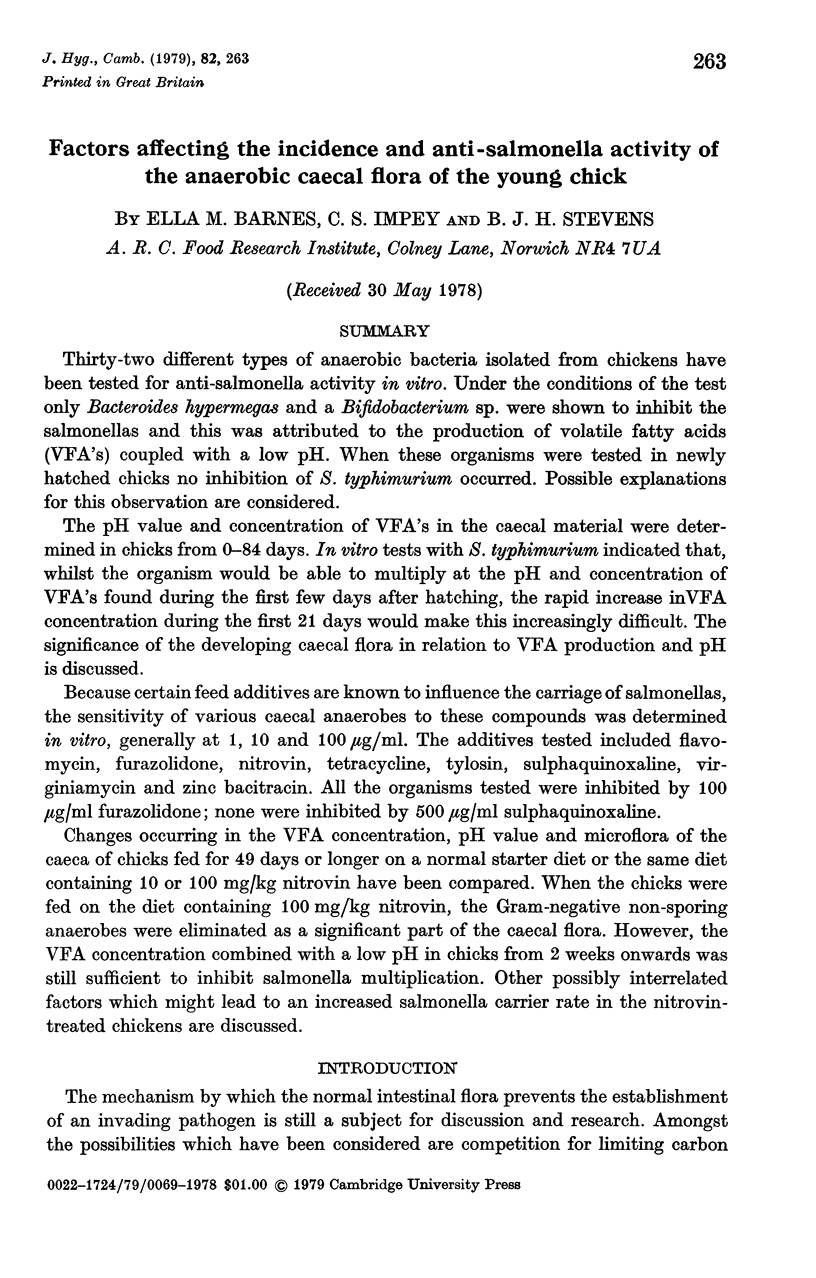
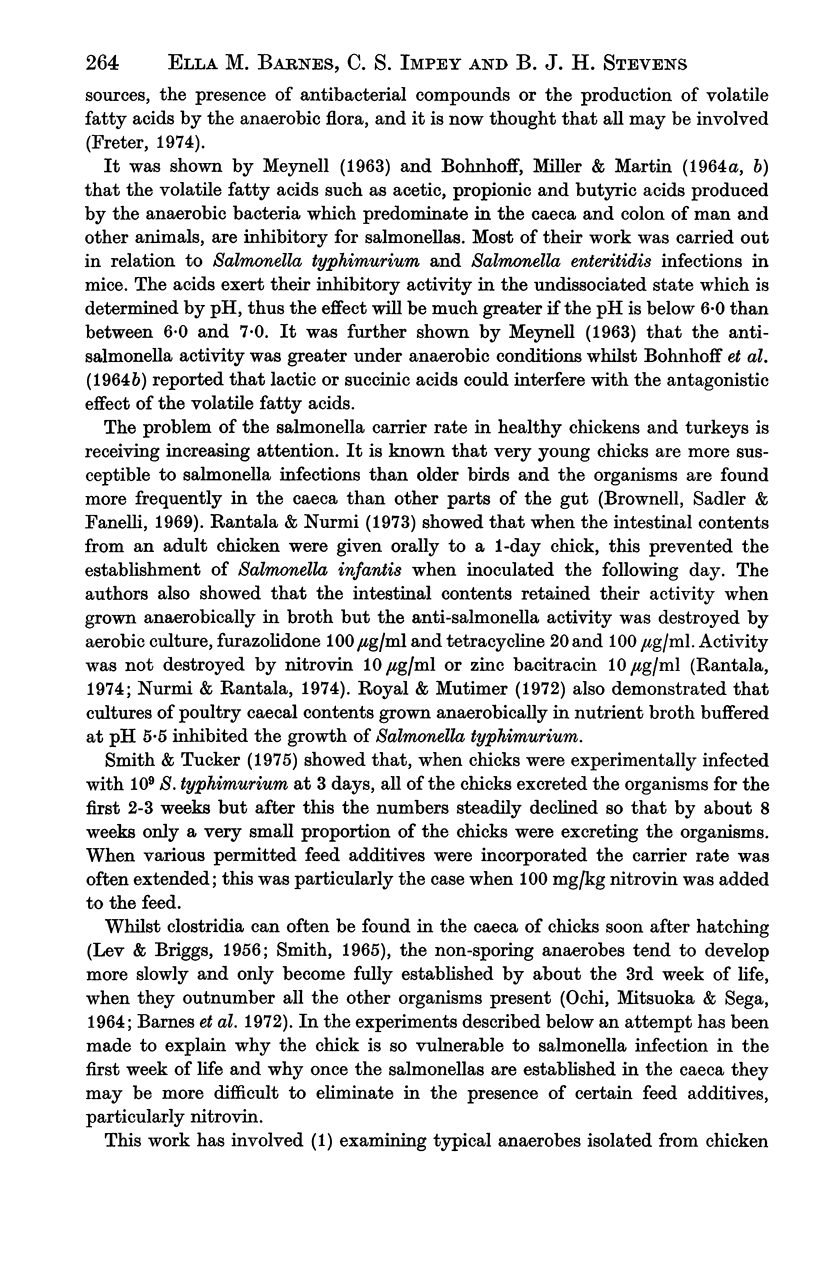
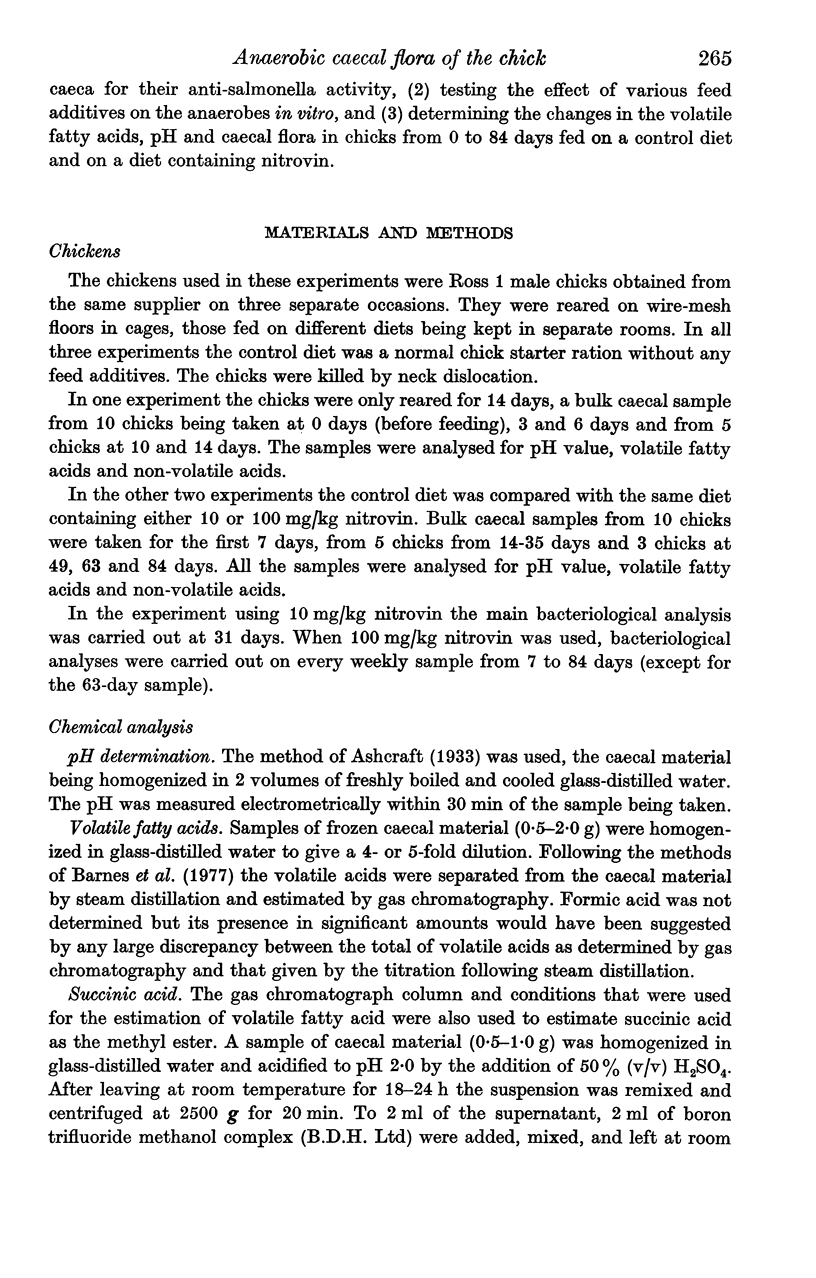

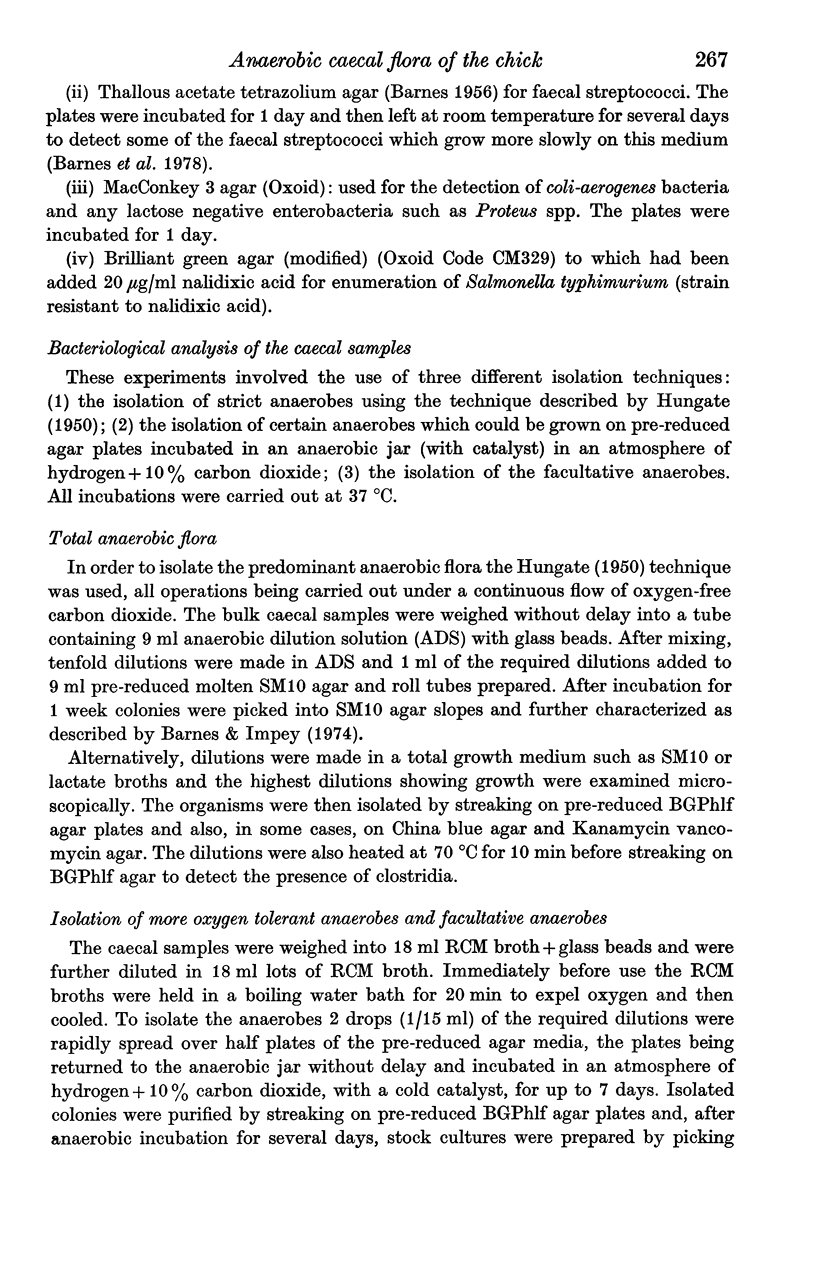
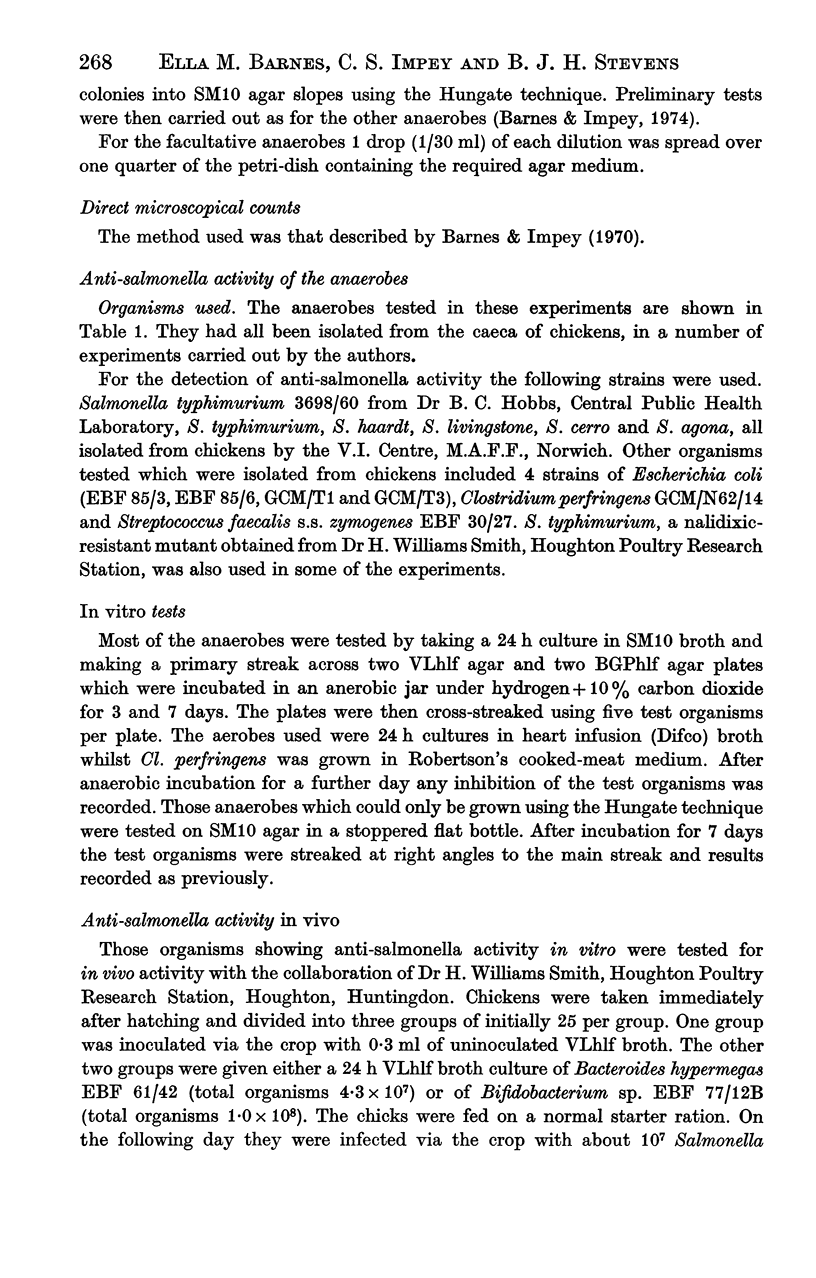
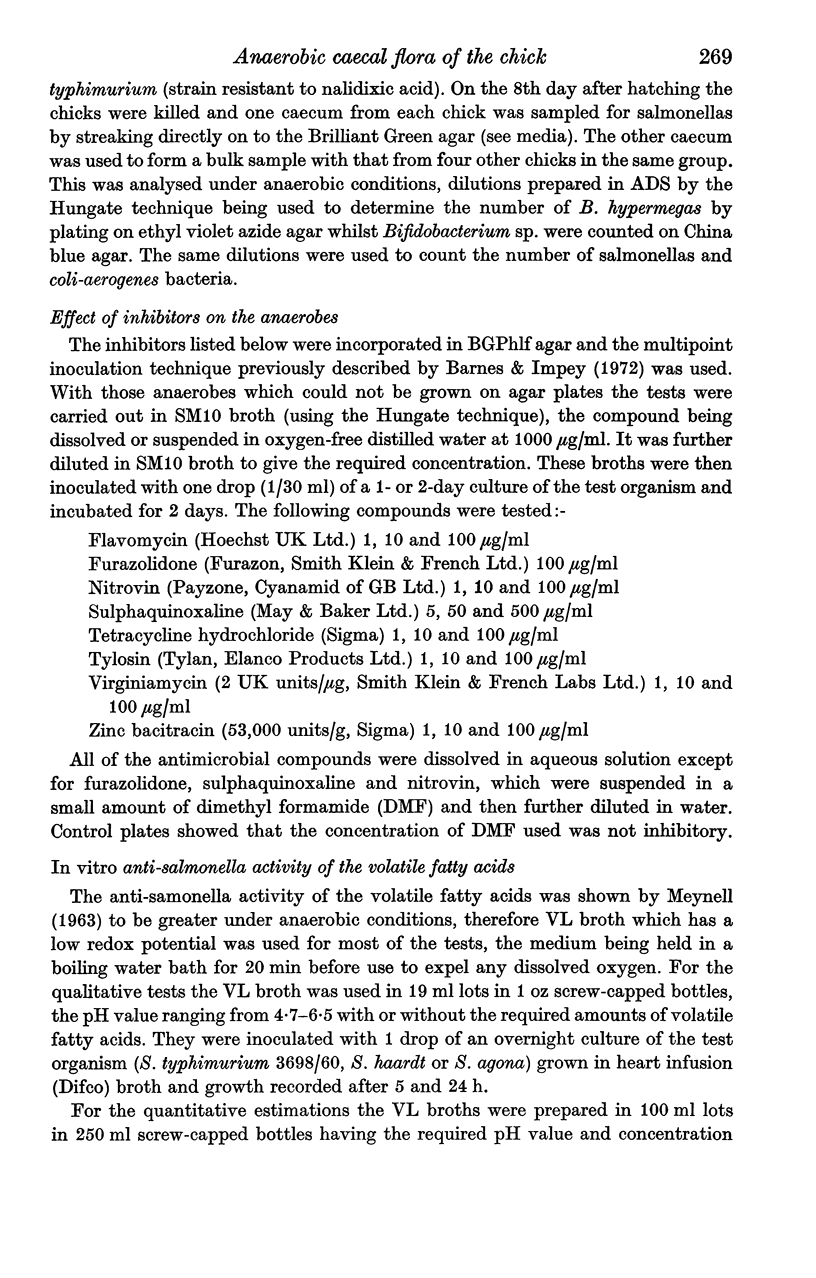
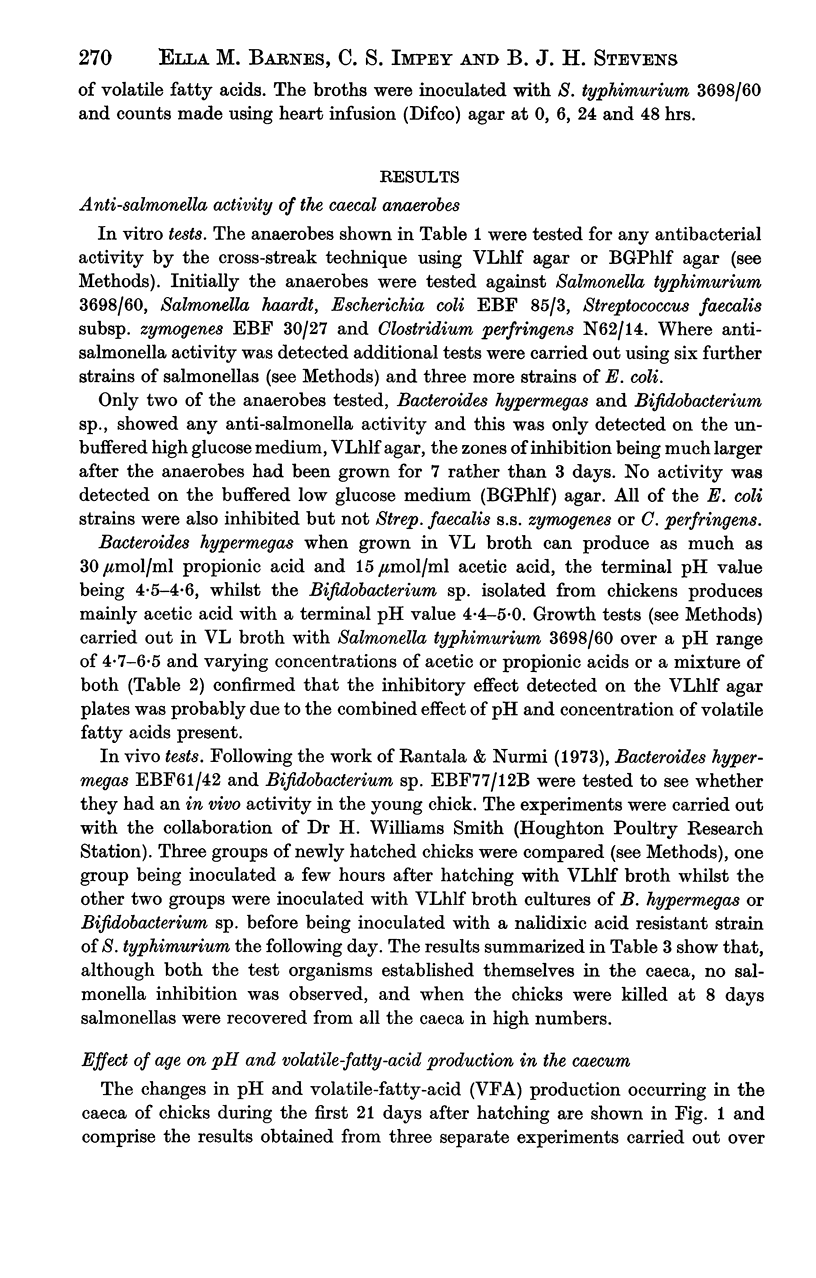
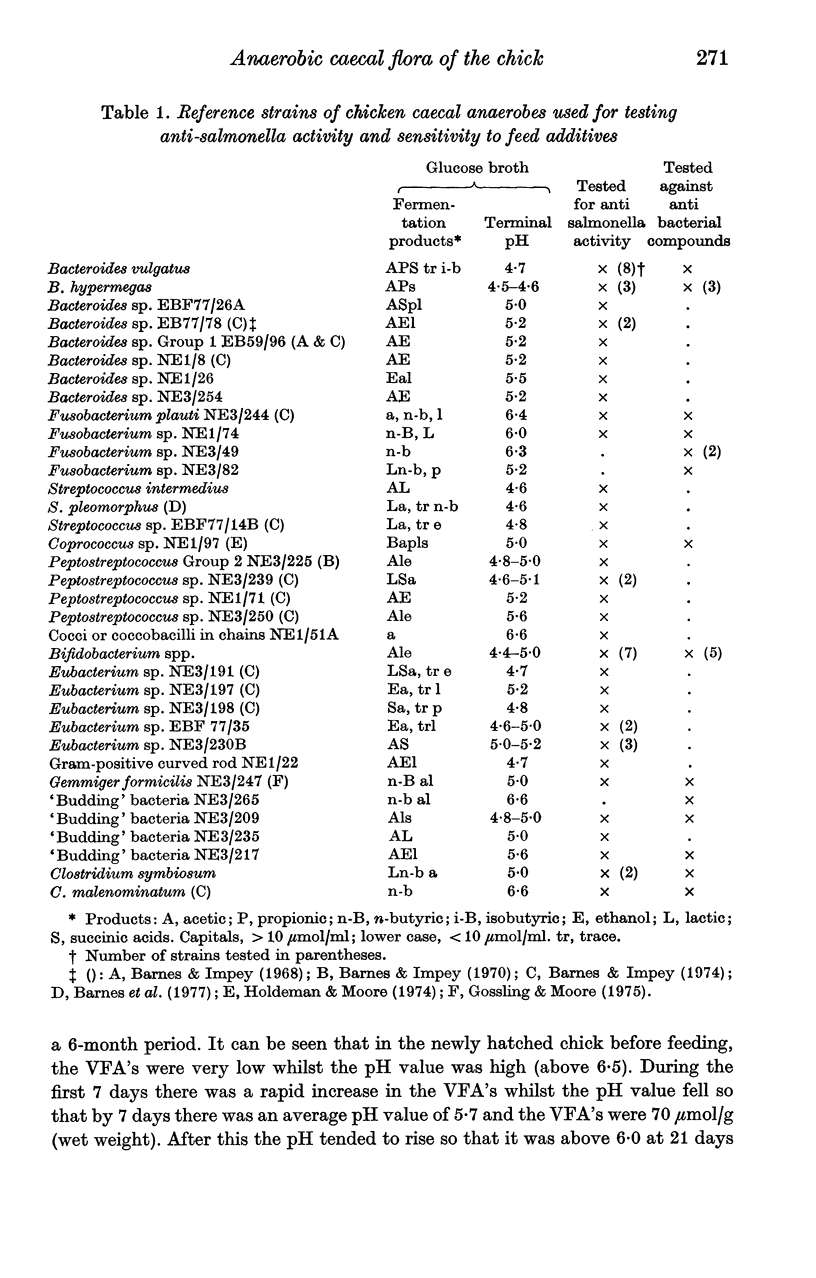
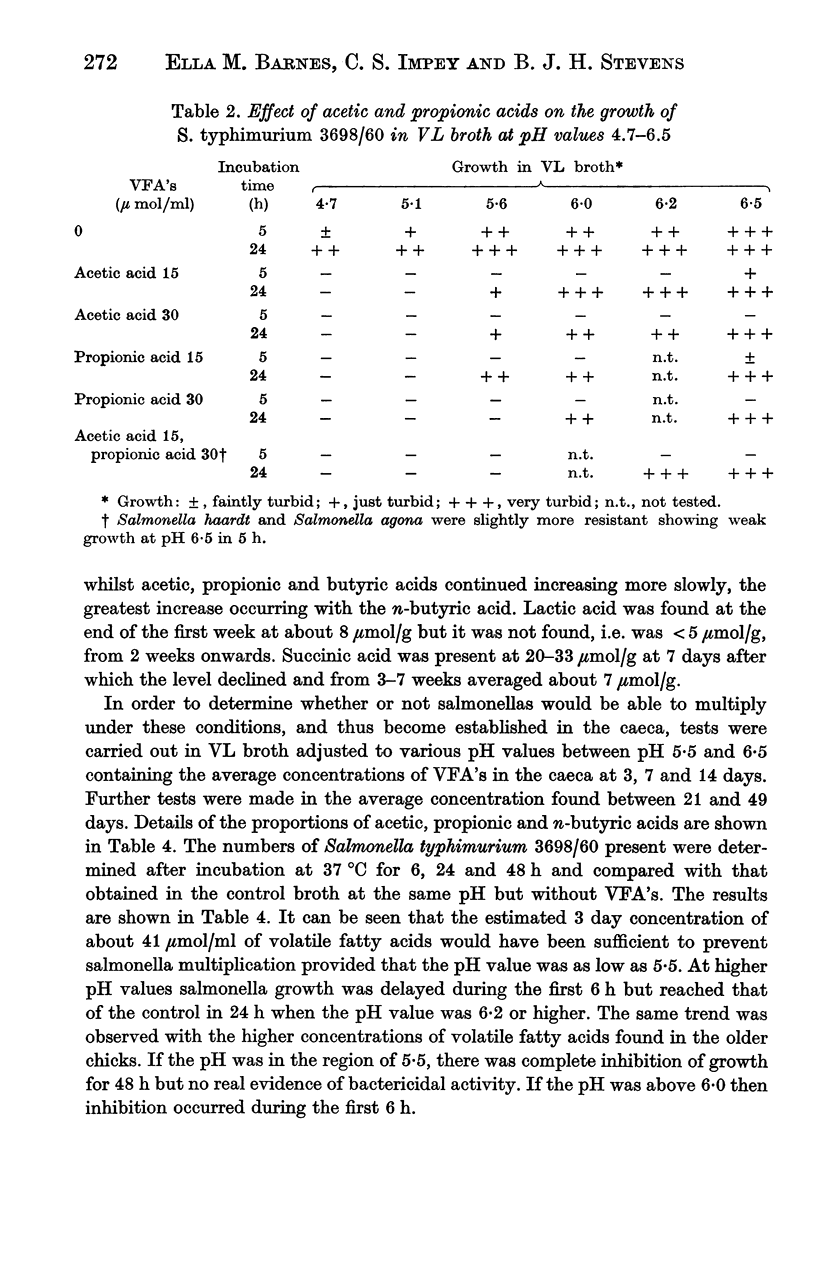
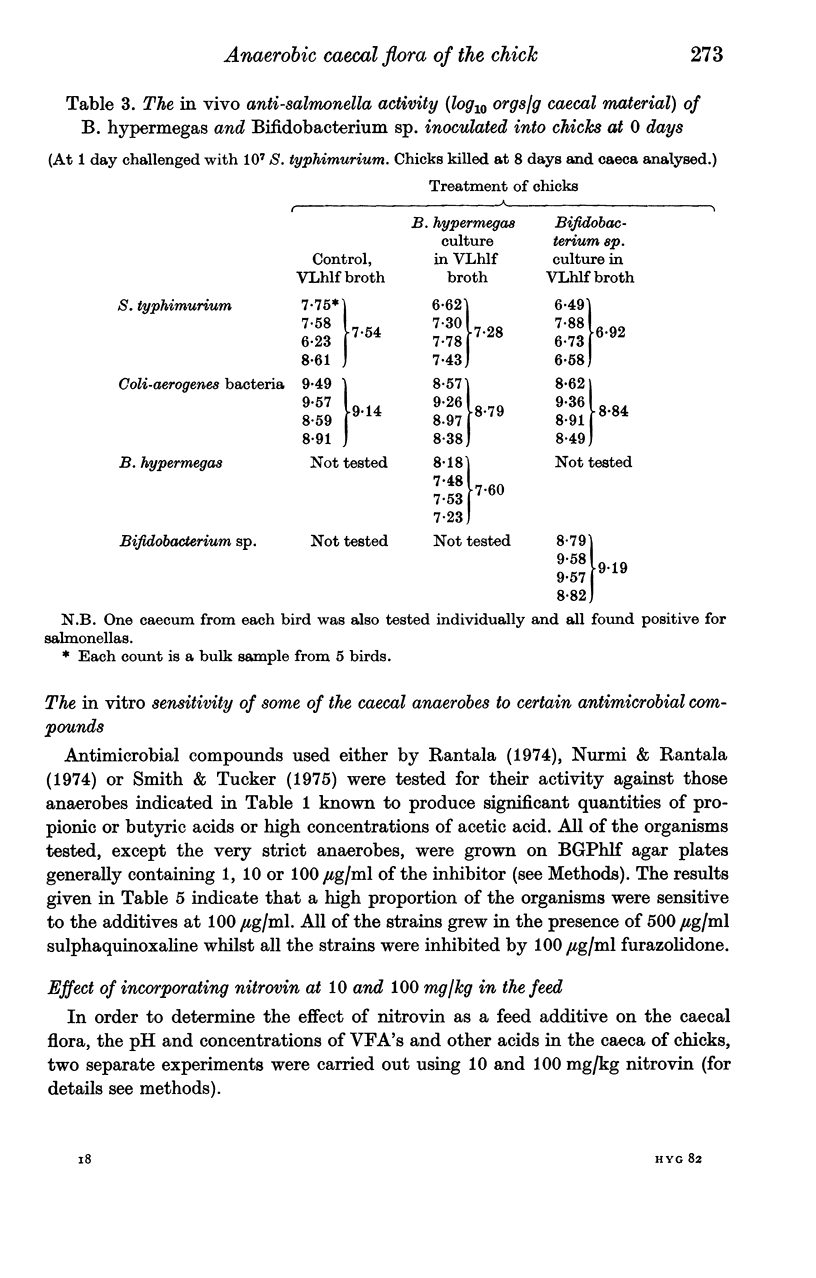
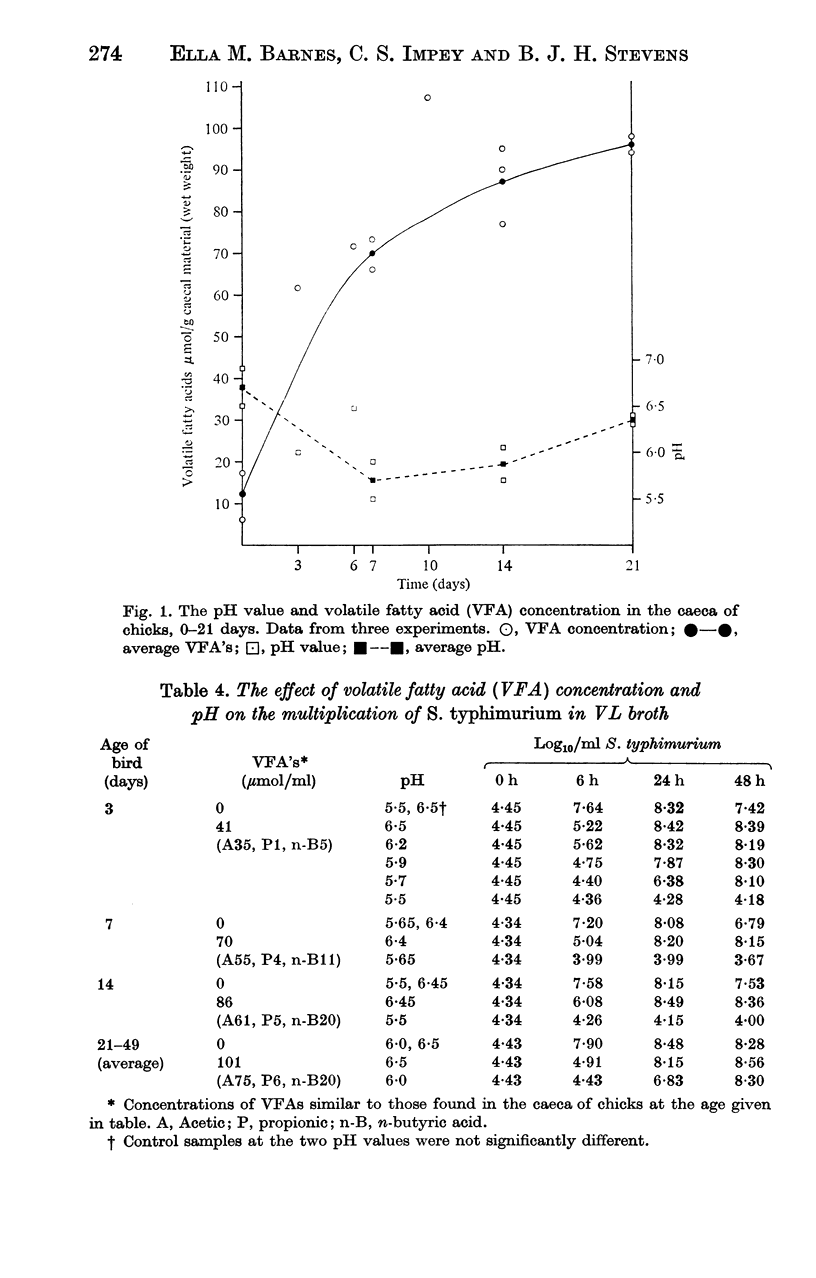
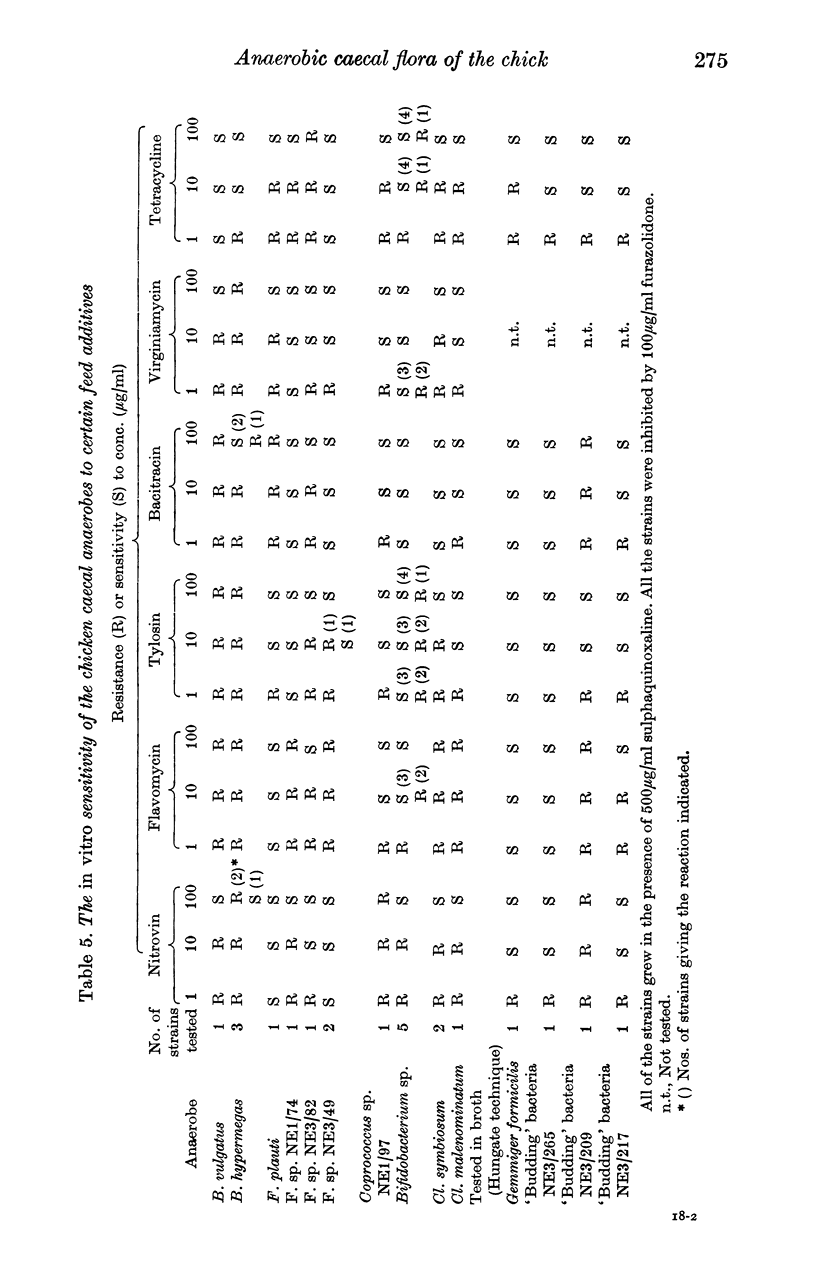
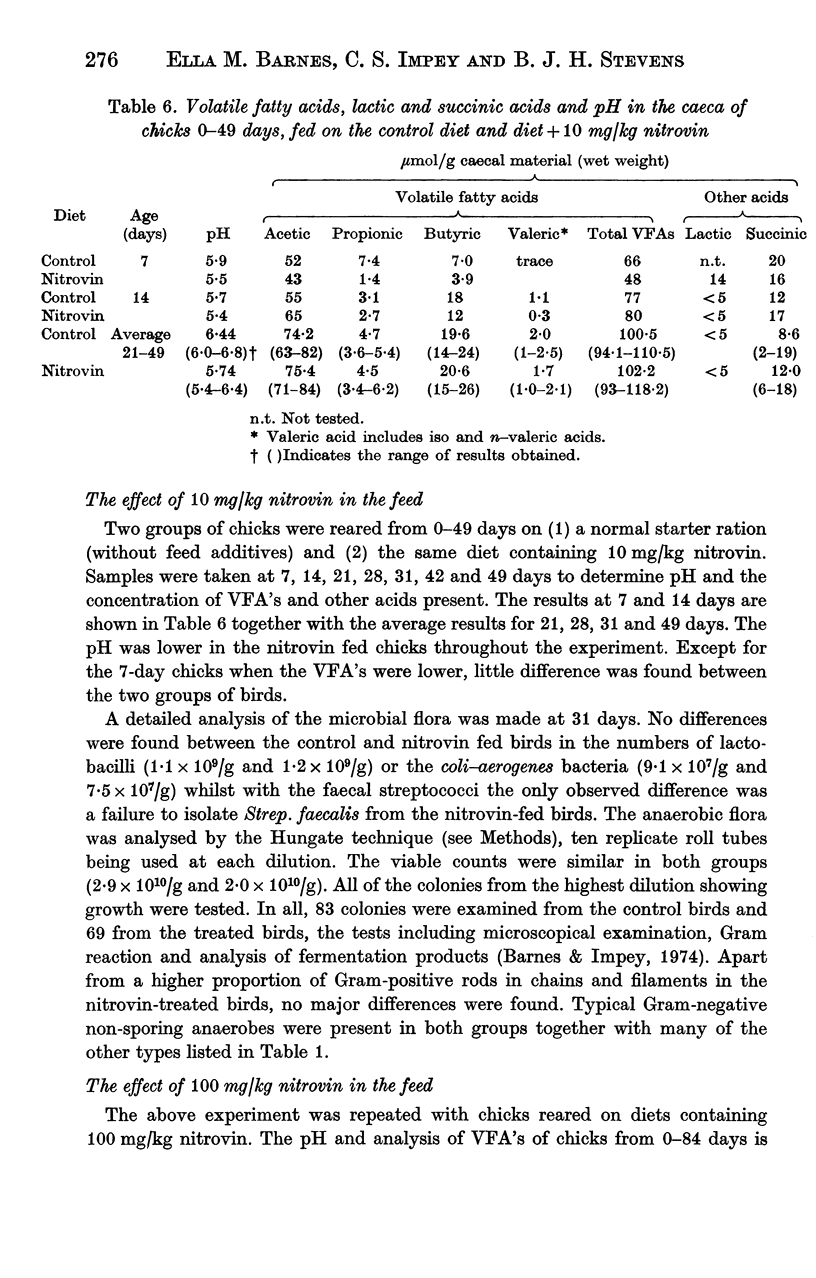

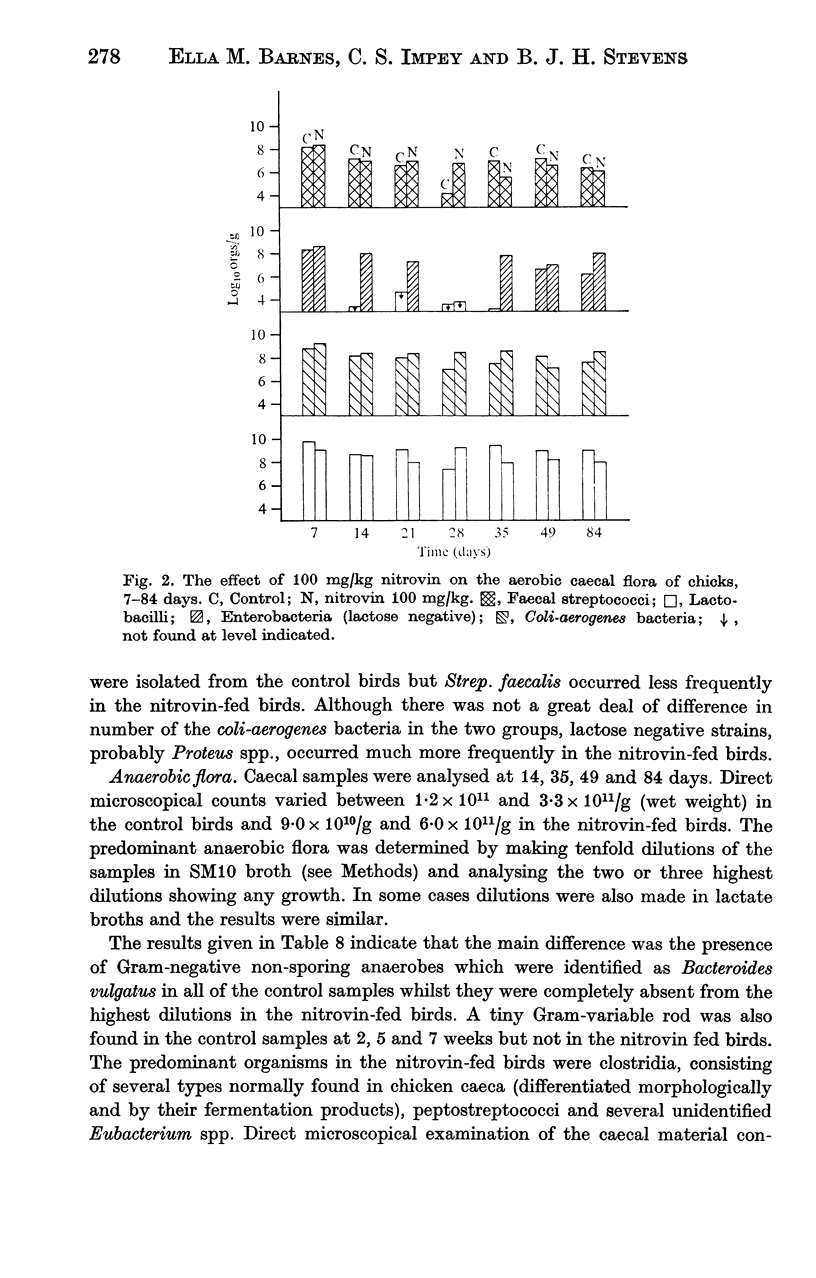

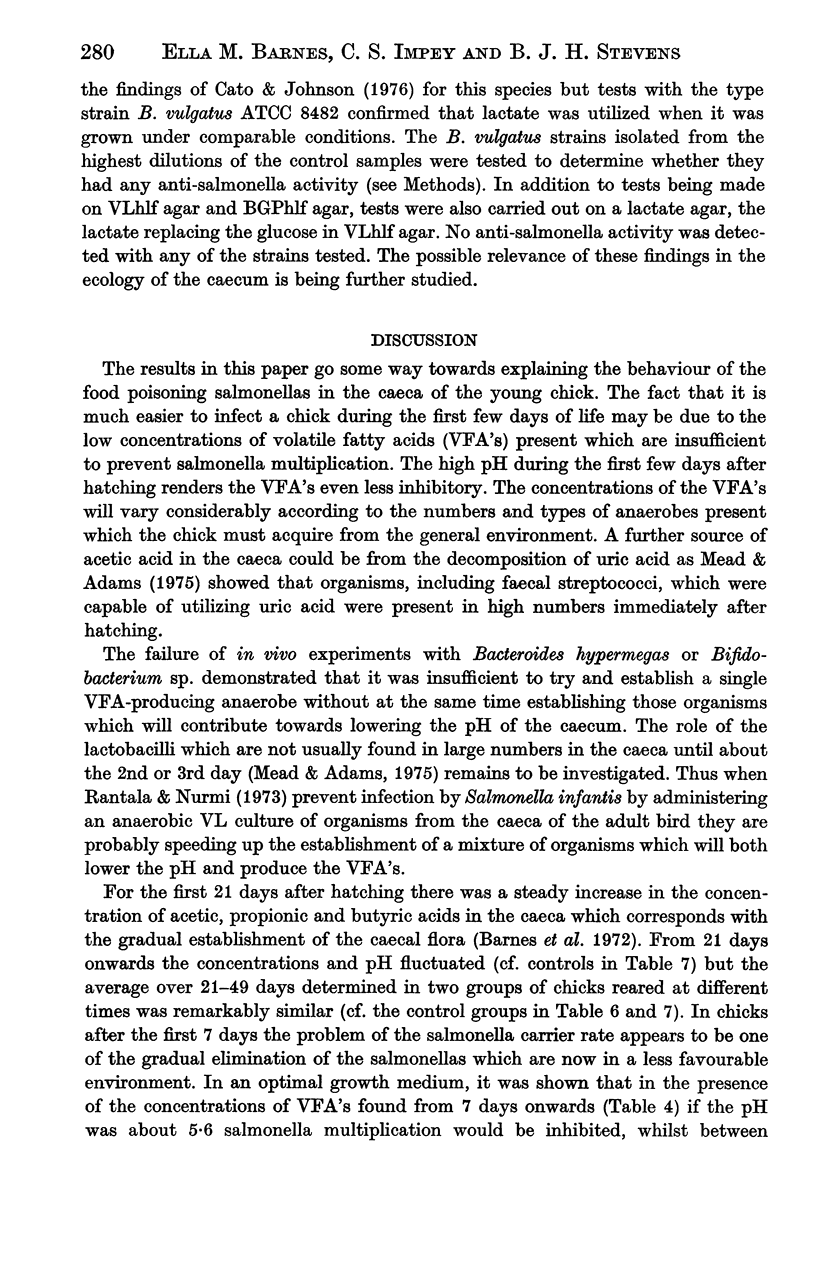
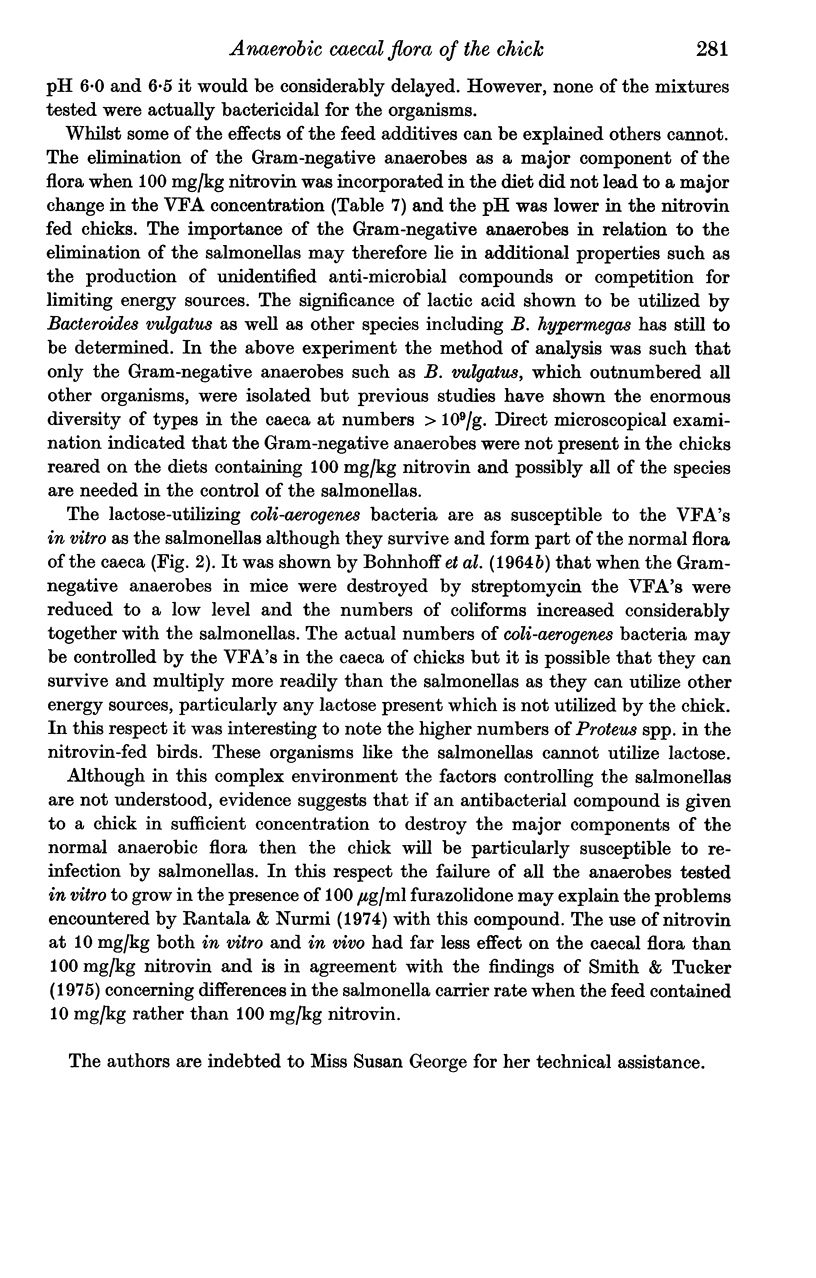
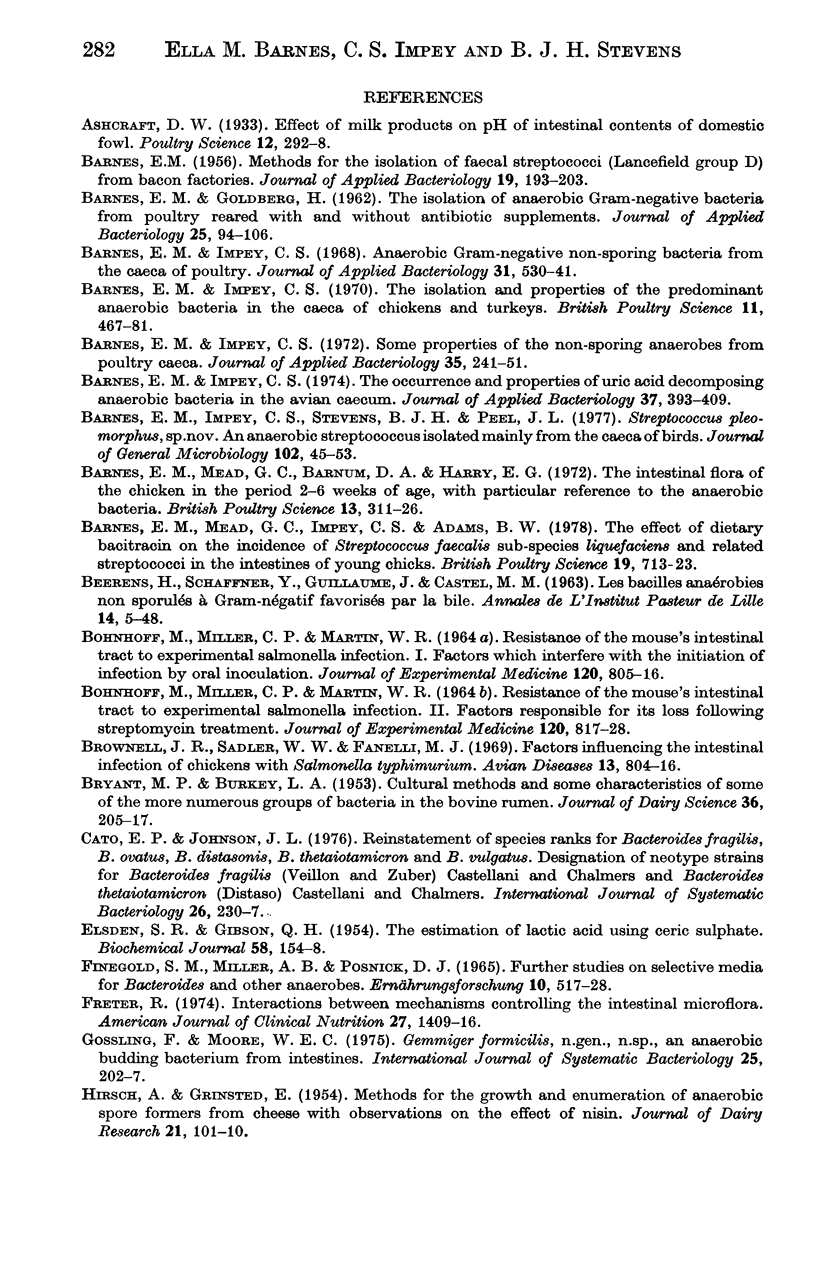
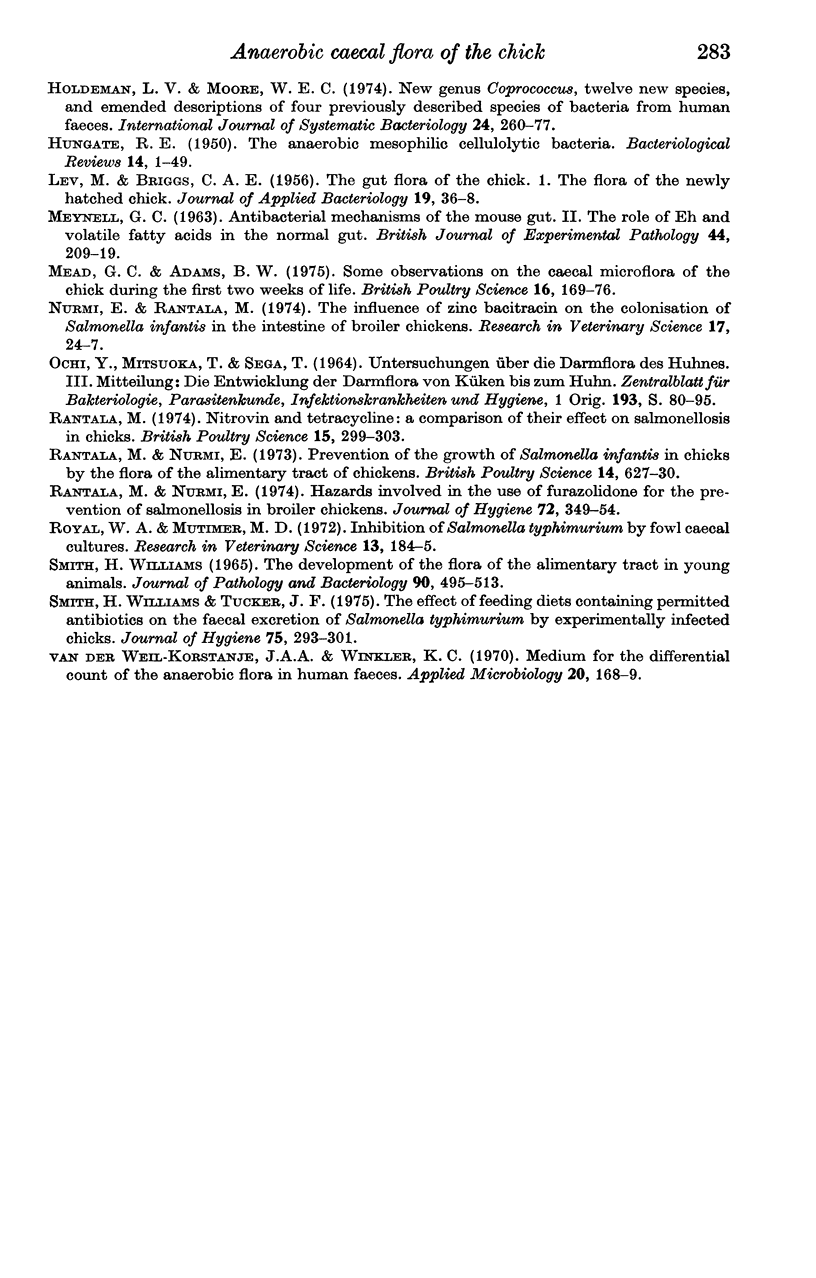
Selected References
These references are in PubMed. This may not be the complete list of references from this article.
- BEERENS H., SCHAFFNER Y., GUILLAUME J., CASTEL M. M. LES BACILLES ANA'EROBIES NON SPORUL'ES 'A GRAM N'EGATIF FAVORIS'ES PAR LA BILE. LEUR APPARTENANCE AU GENRE EGGERTHELLA (NOV. GEN) Ann Inst Pasteur Lille. 1963;14:5–48. [PubMed] [Google Scholar]
- BOHNHOFF M., MILLER C. P., MARTIN W. R. RESISTANCE OF THE MOUSE'S INTESTINAL TRACT TO EXPERIMENTAL SALMONELLA INFECTION. I. FACTORS WHICH INTERFERE WITH THE INITIATION OF INFECTION BY ORAL INOCULATION. J Exp Med. 1964 Nov 1;120:805–816. doi: 10.1084/jem.120.5.805. [DOI] [PMC free article] [PubMed] [Google Scholar]
- BOHNHOFF M., MILLER C. P., MARTIN W. R. RESISTANCE OF THE MOUSE'S INTESTINAL TRACT TO EXPERIMENTAL SALMONELLA INFECTION. II. FACTORS RESPONSIBLE FOR ITS LOSS FOLLOWING STREPTOMYCIN TREATMENT. J Exp Med. 1964 Nov 1;120:817–828. doi: 10.1084/jem.120.5.817. [DOI] [PMC free article] [PubMed] [Google Scholar]
- Barnes E. M., Impey C. S. Anaerobic gram negative nonsporing bacteria from the caeca of poultry. J Appl Bacteriol. 1968 Dec;31(4):530–541. doi: 10.1111/j.1365-2672.1968.tb00402.x. [DOI] [PubMed] [Google Scholar]
- Barnes E. M., Impey C. S. Some properties of the nonsporing anaerobes from poultry caeca. J Appl Bacteriol. 1972 Jun;35(2):241–251. doi: 10.1111/j.1365-2672.1972.tb03696.x. [DOI] [PubMed] [Google Scholar]
- Barnes E. M., Impey C. S., Stevens B. J., Peel J. L. Streptococcus pleomorphus sp.nov.: an anaerobic streptococcus isolated mainly from the caeca of birds. J Gen Microbiol. 1977 Sep;102(1):45–53. doi: 10.1099/00221287-102-1-45. [DOI] [PubMed] [Google Scholar]
- Barnes E. M., Impey C. S. The isolation and properties of the predominant anaerobic bacteria in the caeca of chickens and turkeys. Br Poult Sci. 1970 Oct;11(4):467–481. doi: 10.1080/00071667008415842. [DOI] [PubMed] [Google Scholar]
- Barnes E. M., Impey C. S. The occurence and properties of uric acid decomposing anaerobic bacteria in the avian caecum. J Appl Bacteriol. 1974 Sep;37(3):393–409. doi: 10.1111/j.1365-2672.1974.tb00455.x. [DOI] [PubMed] [Google Scholar]
- Barnes E. M., Mead G. C., Barnum D. A., Harry E. G. The intestinal flora of the chicken in the period 2 to 6 weeks of age, with particular reference to the anaerobic bacteria. Br Poult Sci. 1972 May;13(3):311–326. doi: 10.1080/00071667208415953. [DOI] [PubMed] [Google Scholar]
- Brownell J. R., Sadler W. W., Fanelli M. J. Factors influencing the intestinal infection of chickens with Salmonella typhimurium. Avian Dis. 1969 Nov;13(4):804–816. [PubMed] [Google Scholar]
- ELSDEN S. R., GIBSON Q. H. The estimation of lactic acid using ceric sulphate. Biochem J. 1954 Sep;58(1):154–158. doi: 10.1042/bj0580154. [DOI] [PMC free article] [PubMed] [Google Scholar]
- Freter R. Interactions between mechanisms controlling the intestinal microflora. Am J Clin Nutr. 1974 Dec;27(12):1409–1416. doi: 10.1093/ajcn/27.12.1409. [DOI] [PubMed] [Google Scholar]
- HUNGATE R. E. The anaerobic mesophilic cellulolytic bacteria. Bacteriol Rev. 1950 Mar;14(1):1–49. doi: 10.1128/br.14.1.1-49.1950. [DOI] [PMC free article] [PubMed] [Google Scholar]
- MEYNELL G. G. Antibacterial mechanisms of the mouse gut. II. The role of Eh and volatile fatty acids in the normal gut. Br J Exp Pathol. 1963 Apr;44:209–219. [PMC free article] [PubMed] [Google Scholar]
- Mead G. C., Adams B. W. Some observations on the caecal microflora of the chick during the first two weeks of life. Br Poult Sci. 1975 Mar;16(2):169–176. doi: 10.1080/00071667508416174. [DOI] [PubMed] [Google Scholar]
- Nurmi E., Rantala M. The influence of zinc bacitracin on the colonization of Salmonella infantis in the intestine of broiler chickens. Res Vet Sci. 1974 Jul;17(1):24–27. [PubMed] [Google Scholar]
- Ochi Y., Mitsuoka T., Sega T. Untersuchungen über die Darmflora des Huhnes. III. Die Entwicklung der Darmflora von Küken bis zum Huhn. Zentralbl Bakteriol Orig. 1964 Jun;193(1):80–95. [PubMed] [Google Scholar]
- Rantala M. Nitrovin and tetracycline: a comparison of their effect on salmonellosis in chicks. Br Poult Sci. 1974 May;15(3):299–303. doi: 10.1080/00071667408416110. [DOI] [PubMed] [Google Scholar]
- Rantala M., Nurmi E. Hazards involved in the use of furazolidone for the prevention of salmonellosis in broiler chickens. J Hyg (Lond) 1974 Jun;72(3):349–354. doi: 10.1017/s0022172400023573. [DOI] [PMC free article] [PubMed] [Google Scholar]
- Rantala M., Nurmi E. Prevention of the growth of Salmonella infantis in chicks by the flora of the alimentary tract of chickens. Br Poult Sci. 1973 Nov;14(6):627–630. doi: 10.1080/00071667308416073. [DOI] [PubMed] [Google Scholar]
- Royal W. A., Mutimer M. D. Inhibition of Salmonella typhimurium by fowl caecal cultures. Res Vet Sci. 1972 Mar;13(2):184–185. [PubMed] [Google Scholar]
- Smith H. W. The development of the flora of the alimentary tract in young animals. J Pathol Bacteriol. 1965 Oct;90(2):495–513. [PubMed] [Google Scholar]
- Smith H. W., Tucker J. F. The effect of feeding diets containing permitted antibiotics on the faecal excretion of Salmonella typhimurium by experimentally infected chickens. J Hyg (Lond) 1975 Oct;75(2):293–301. doi: 10.1017/s0022172400047318. [DOI] [PMC free article] [PubMed] [Google Scholar]
- Wiel-Korstanje JA van D., Winkler K. C. Medium for differential count of the anaerobic flora in human feces. Appl Microbiol. 1970 Jul;20(1):168–169. doi: 10.1128/am.20.1.168-169.1970. [DOI] [PMC free article] [PubMed] [Google Scholar]


